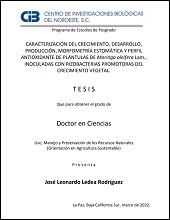| dc.contributor.advisor | Angulo Valadez, Carlos Eliud | |
| dc.contributor.advisor | REYES PEREZ, JUAN JOSE | |
| dc.contributor.author | Ledea Rodríguez, José | |
| dc.date.issued | 2022 | |
| dc.identifier | https://cibnor.repositorioinstitucional.mx/jspui/handle/1001/2646 | |
| dc.identifier.uri | http://dspace.cibnor.mx:8080/handle/123456789/3115 | |
| dc.description.abstract | "La especie Moringa oleifera Lam. es un árbol caducifolio que se utiliza en la alimentación y tratamiento de enfermedades de humanos y animales. El objetivo del presente estudio fue caracterizar el crecimiento, producción, desarrollo, morfología estomática y composición bioquímica de M. oleifera Lam. inoculada con rizobacterias promotoras del crecimiento vegetal (PGPR) (Bacillus niacini (Y11), Moraxella osloensis (Y13), Bacillus cereus (A11) y Azospirillum brasilense Cd (DSM 1843) en condiciones de invernadero. Los resultados de la morfología estomática muestran que, las hojas de plantas inoculadas con B. cereus presentaron estomas más pequeños, respecto al resto de los inóculos y control (CT). En el caso de M. osloensis, esta indujo cambios (P≤0.001) en el largo y ancho de los estomas; las hojas al resultaron hipostomática de paredes anticlinales onduladas y aparatos estomáticos anomocíticos. En la evaluación del crecimiento y desarrollo de plantas inoculadas con PGPR, A. brasilense promovió una mayor altura en la planta (67.17 cm) (P≤0.01) respecto al control (43.54 cm); M. osloensis y B. cereus en conjunto, incrementaron (P≤0.001) el número de hojas (11.45 y 11.85, Vs 8.68 del CT, respectivamente). En cuanto a los rendimiento de biomasa seca (BS) de hojas y planta íntegra (PI) las plantas inoculadas con B. cereus propiciaron mayores (P≤0.01) rendimientos de biomasa seca (BS) de hojas (0.80 Vs 0.26 t BS ha-1 del control) y planta íntegra (12.92 Vs 5.52 t BS ha-1 del control). En cuanto a la morfofisiología de la planta, B. cereus promovió (P≤0.01) el desarrollo de área foliar (AF) (20.28 cm2); índice de área foliar (IAF) (21.13) y duración del área foliar (DAF) (4.78 cm2día-1) respecto al CT (13.9 cm2; 14.71; -1.57 cm2día-1, para AF, IAF y DAF, respectivamente), mientras que las tasas de crecimiento absoluto (TCA) y relativo (TCR) fueron mayores con los inóculos A. brasilense y M. osloensis en TCA (1.037 y 0.93 cm2 día-1 Vs 0.12 del CT) y TCR (0.014 cm día-1*10-3 con ambos inóculos Vs 0.002 cm día-1*10-3 del CT). Los inóculos bacterianos no promovieron diferencias (P≥0.05) en la concentración de pigmentos fotosintéticos ni de polifenoles totales, pero sí (P≤0.001) en el contenido de flavonoides totales respecto al CT (6.22 mg equivalente de Quercetina g extracto-1)..." | es |
| dc.format | pdf | es |
| dc.language.iso | spa | es |
| dc.publisher | Centro de Investigaciones Biológicas del Noroeste, S.C. | es |
| dc.rights | Acceso abierto | es |
| dc.subject | Moringaceae, Brassicales, PGPR, Baja California Sur, metabolitos secundarios. | es |
| dc.subject.classification | Moringaceae, Brassicales, PGPR, Baja California Sur, secundary metabolites. | es |
| dc.title | CARACTERIZACIÓN DEL CRECIMIENTO, DESARROLLO, PRODUCCIÓN, MORFOMETRÍA ESTOMÁTICA Y PERFIL ANTIOXIDANTE DE PLÁNTULAS DE Moringa oleifera Lam., INOCULADAS CON RIZOBACTERIAS PROMOTORAS DEL CRECIMIENTO VEGETAL | es |
| dc.type | doctoralThesis | es |
| dc.dirtesis.grado | Doctorado en Ciencias en el Uso, Manejo y Preservación de los Recursos Naturales | es |
| dc.dirtesis.disciplina | Agricultura Sustentable | es |
| dc.dirtesis.universidad | Centro de Investigaciones Biológicas del Noroeste, S.C. | es |
| dc.dirtesis.facultad | Posgrado en Recursos Naturales | es |
| dc.description.abstracten | "The species Moringa oleifera Lam. It is a deciduous tree that is used in food and treatment of human and animal diseases. The objective of the present study was to characterize the growth, production, development, stomatal morphology and biochemical composition of M. oleifera Lam. inoculated with plant growth promoting rhizobacteria (PGPR) (Bacillus niacini (Y11), Moraxella osloensis (Y13), Bacillus cereus (A11) and Azospirillum brasilense Cd (DSM 1843)) under greenhouse conditions. The stomatal morphology results, the leaves of plants inoculated with B. cereus presented smaller stomata, compared to the rest of the inoculums and control (CT). In the case of M. osloensis, this induced changes (P≤0.001) in the length and width of the stomata; the leaves were hypostomatic with wavy anticline walls and anomocytic stomatal apparatuses. In the evaluation of the growth and development of plants inoculated with PGPR, A. brasilense promoted a greater height in the plant (67.17 cm) (P≤0.01) compared to the control. (43.54 cm); M. osloensis and B. cereus as a whole, increased (P≤0.001) the number of leaves (11.45 and 11.85, Vs 8.68 of the TC, respectively). Regarding the dry biomass yield (DBY) of leaves and whole plant (WP). The plants inoculated with B. cereus led to higher (P≤0.01) yields of dry biomass of leaves (0.80 Vs 0.26 t DBY ha-1 of the control) and WP (12.92 Vs 5.52 t DBY ha-1 of the control). Regarding the morphophysiology of the plant, B. cereus promoted (P≤0.01) the development of leaf area (LA) (20.28 cm2); leaf area index (LAI) (21.13) and duration of leaf area (DLA) (4.78 cm2day-1) with respect to TC (13.9 cm2; 14.71; -1.57 cm2day-1, for LA, LAI and DLA, respectively), absolute growth rate (AGR) and relative (RGR) growth rate were higher with the A. brasilense and M. osloensis inocula in AGR (1.037 and 0.93 cm2 day-1 Vs 0.12 cm2 day-1 of the CT) and RGR (0.014 cm day-1 * 10-3 with both inoculums Vs 0.002 cm day-1 * 10-3 of the CT). Bacterial inocula did not promote differences (P≥0.05) in the concentration of photosynthetic pigments or total polyphenols, but did (P≤0.001) in the content of total flavonoids with respect to TC (6.22 mg equivalent of Quercetin g extract-1). Regarding the mineral composition of the plant, the concentration of mineral elements in leaves only showed significant differences (P≤0.001) in the content of Mg2+ and K+ promoted by B. niacini..." | es |

